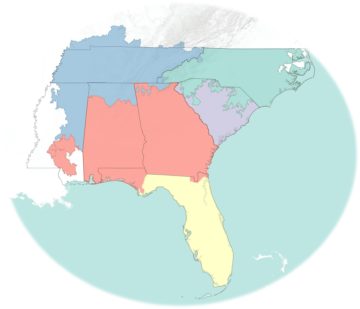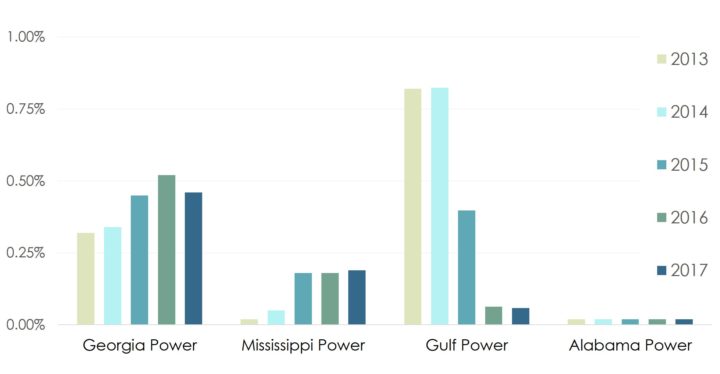
Energy efficiency is the most cost-effective way to save energy and money without building new infrastructure. Investments in energy efficiency pay off by reducing energy bills, they improve the comfort of our homes and increase the productivity of businesses.
Over the past five years in the Southeast, efficiency has helped avoid the carbon emissions equivalent of 1.1 million cars and offset the need for at least twenty 600 MW gas-fired power plants. Some of these benefits are the result of advances in technology, federal lighting and appliance standards, and better building codes. The other major driver for energy efficiency comes from utility-run energy efficiency programs, funded by rates and justified by the lower bills that result.
Today SACE is proud to release our 2018 Energy Efficiency in the Southeast report – which finds that in 2017, utility-administered efficiency programs in the Southeast eliminated 2,375 GWh of energy waste, cut CO2 emissions by over 1 million tons, and achieved 11,206 MW of peak energy-saving capacity. This is enough energy to power 2.1 million homes for a year.
In this report, SACE offers our seventh annual evaluation of Southeastern utilities’ efficiency programs to highlight those who are leading, those who are lagging, and the factors that determine success.

Leaders are scarce in the Southeast

Of the major utility companies in the Southeast, only Duke Energy exceeded the national average in 2017 (1.09% for Duke Energy Carolinas, and 0.79% for Duke Energy Progress). Duke Energy Carolinas in 2017 was the first utility in the Southeast to achieve 1% annual efficiency savings, eclipsing its sister company Progress Energy, which had reached very close to the mark in 2016. As outlined in our report, Duke’s success was driven by three key factors that have proven to be consistent indicators of success and failure across the Southeast:
- Utility management leadership
- Supportive legislative and regulatory policies, and
- Consistent and meaningful stakeholder engagement.
Other than Duke Energy, several fairly small utilities also report high levels of annual efficiency savings, but we have not verified the data they reported to the federal government.
Compared with other regions of the country, the Southeast is trailing far behind. In 2017, the Southeast regional average for efficiency savings was just 0.29% of the previous year’s electricity sales. This is less than half of the national average (0.69%). The top two regions in the country, New England (1.5%) and the Pacific (1.2%), reduce energy waste at a rate that is 4-5 times greater than the Southeast.
Momentum is missing

No utility company in the Southeast demonstrates as stark a contrast between success and failure with energy efficiency as Southern Company. And it points to a failure of leadership by the region’s public officials and energy executives.
Just a few years ago, Southern Company subsidiary Gulf Power was directly competing with Duke Energy as one of the clear leaders in the Southeast. Jump ahead a few years and Gulf Power’s efficiency performance plummeted a staggering 92% to nearly zero in 2017.
The two largest Southern Company subsidiaries also present a study in contrasts. Georgia Power’s 0.45% annual efficiency savings, while not particularly impressive, is nonetheless the region’s third-highest performer. Alabama Power earns the ignominy of being the region’s worst major utility, offering essentially no energy efficiency programs.
The differences in efficiency performance between these operating companies goes back to the three key indicators noted above. In Georgia, public officials are mildly supportive, a stakeholder group meets regularly, and the utility management executes on programs with professionalism. In contrast, a complete lack of energy efficiency policy in Alabama and deeply flawed policy in Florida combined with an utter lack of stakeholder engagement and hostile utility management attitudes toward efficiency at Alabama Power and Gulf Power.
Similarly influenced by the dismal culture and policy in Florida, Duke Energy Florida lags far behind its sister operating companies in the Carolinas. While this can be partly explained by highly regressive energy efficiency policies in the state, the utility’s lack of achievement there nonetheless is glaring.
How to correct the burden of high energy bills

Eliminating energy waste not only drives down utility system costs, it is also the best way to directly help individuals who struggle to pay their monthly energy bills. In many parts of the Southeast, it is common for people of all incomes to spend more than 6% of household income on energy, which is considered the threshold for bills to be “unaffordable.”
When incomes are low, moderate variations in energy usage can force difficult decisions between paying the electricity bill and purchasing medications or enough food to eat. While energy bills can be a challenge even for people who are not necessarily poor, people in the Southeast are more likely to experience poverty than the average American. From Florida, where 16% of households are in poverty, to Mississippi, where the 22% rate is nearly double the national poverty rate, income-qualified utility efficiency programs help to lower bills, which can make a world of difference.
Even as far behind as the Southeast currently is, we estimate that at our current pace energy efficiency could offset the need for 16,000 MW of generating capacity over the next decade, equal to more than twenty 600 MW gas-fired power plants. Or the Southeast could avoid many times more than this if we ramp up to the national average or achieve the higher 1.0% pace set by regional leader Duke Energy Carolinas.
At the policy level, achieving these goals will mean creating rules and management support for energy efficiency in all aspects of electric utility operations, policy, and regulation, especially:
- Fully integrated resource planning
- Direct competition with proposed power plants
- Programs to help all customers lower their bills
And for the more successful programs, like Duke Energy, maintaining leadership will require the utilities to develop new strategies. Some of the key challenges include:
- Heavy reliance on short-term energy-saving programs, which will be substantially reduced by changes to federal lighting standards.
- High percentages of commercial and industrial customers opting-out of the utility energy efficiency programs, which would otherwise yield many of the most cost-effective opportunities.
Over the next few weeks, we will be blogging on some of the more specific challenges at utilities like SCE&G, Tennessee Valley Authority, and Florida Power & Light (FPL). We look forward to a discussion with our readers about how utilities should help customers save energy and reduce waste.
Read Part 2 of the blog series where we look at SCE&G who are at a crossroads for energy efficiency.
Read Part 3, examining Georgia Power’s energy efficiency efforts.
Read Part 4, looking at FP&L who are dragging Florida down with a lack of investment in energy efficiency.
Learn more about SACE’s Energy Efficiency Efforts here.



